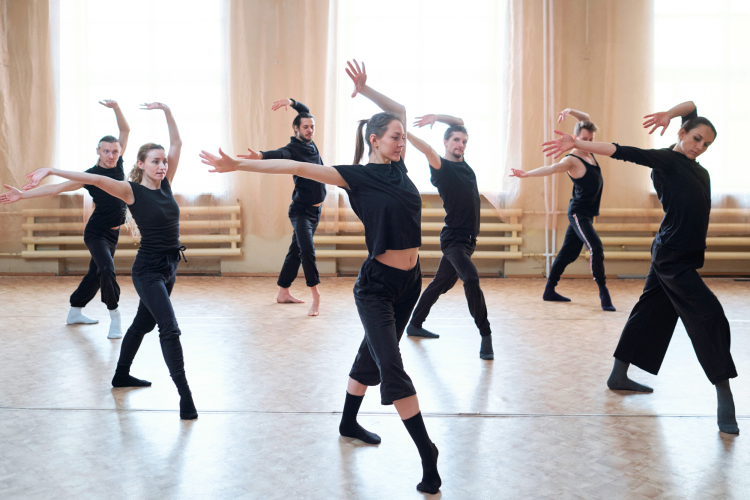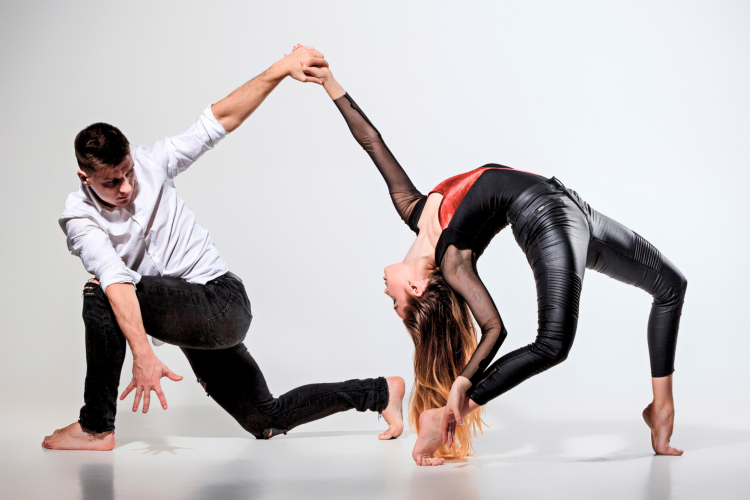What Is Contemporary Dance? A Deep Dive into the the Art of Free Movement

So, what is contemporary dance? Great question! It’s one of the newest dance forms with an amazing history and exciting movements. In this article, we’ll discuss what contemporary dance is, its history and how to do it.
Every person deserves to find a type of dance that inspires and motivates them. Contemporary dance provides a space for dancers and spectators to express themselves and explore the beautiful art of dance.
Jump to Section
- What is Contemporary Dance?
- History of Contemporary Dance - Who Started it and When?
- What Are the Features of Contemporary Dance?
- Can Anyone Start Contemporary Dance?
- Benefits of Getting Your Groove on
What is Contemporary Dance?

How do you describe contemporary dance? The best description is watching it live. We’ll do our best to provide a background that allows you to fully grasp this unique style before seeing a performance (if you haven’t already).
Contemporary dance is a genre of dance that embraces fluidity and the expression of individual movement. Contemporary dance breaks from the rules of classic genres like ballet. It allows dancers to break away from ultra-strict structured techniques and the many, many rules. Think improvisation and an eclectic mix of dance styles instead of dance structure. Ballet, for example, is defined by strict practices.
In contrast, contemporary dance is versatile and expressive, exploring deep themes and emotions. Choreographers and dancers alike enjoy the creative possibilities it offers.
History of Contemporary Dance - Who Started it and When?
The roots of contemporary dance began in the early 20th century, emerging, in part, as a response to the rigid structure of ballet and modern dance. Pioneers in dance broke away from traditional forms, seeking a more liberated and personal expression in dance.
From the 1900s to the 1950s, modern dance evolved. So, when was contemporary dance created? By the 1960s and 1970s, the genre of contemporary dance had broken from modern dance and solidified itself as a distinct form. It embraced elements from various other styles while challenging dancers to explore new ways of moving.
Contemporary Dance Trailblazers
Several choreographers have made contemporary dance what it is today. These famous dancers and choreographers mention modern dance and different dance traditions. So, what is the difference between contemporary and modern dance?
Remember, contemporary dance came from modern dance. While the former focuses mainly on the emotions of dancers, the second focuses on creating new techniques and styles. Notice how these innovators play with dance and contribute to the modern understanding of contemporary dance.
Isadora Duncan

Born in 1877, Duncan is often considered the mother of modern dance. She had no formal dance training and rejected the constraints of ballet. Duncan opted for natural movements and a free-spirited approach to dance. She opened dance schools around the world and taught her style to many prominent pupils.
Alvin Ailey
Born in 1931, Ailey blended modern dance, ballet, jazz and African dance to celebrate African American culture. His iconic work, Revelations, brought the Black experience to the stage with emotional depth and theatricality. Ailey founded the Alvin Ailey American Dance Theater, which became a platform for diverse, culturally significant works.
Martha Graham

Graham, born in 1894, pioneered a powerful technique based on "contraction and release," focusing on the body's core and breath. Her choreography is famous to this day and conveys intense emotions and explores themes like mythology and social justice. Her work left a lasting impact on generations of dancers.
Pina Bausch
Bausch (b. 1940) pioneered the dance tradition known as Tanztheater, which merges dance and theater to create emotionally charged, often surreal performances. Her pieces explored love, fear and desire through raw, expressive choreography. Bausch’s work pushed the boundaries of contemporary dance, blending movement with theatrical storytelling.
Merce Cunningham

American dancer and choreographer Merce Cunningham (b. 1919) redefined the relationship between dance and music by allowing them to exist independently. Collaborating with avant-garde composers like John Cage, Cunningham focused on movement and spatial awareness, breaking traditional expectations. His innovative works pushed the boundaries of contemporary dance.
What Are the Features of Contemporary Dance?
There aren’t necessarily defined types of contemporary dance. However, there are versions of contemporary dance. What are the four types of contemporary dance? Well, they lean more on jazz, lyrical, ballet and modern. These types of contemporary dance are fluid and dancers can easily transition from one type to another in a single dance.
The elements of contemporary dance remain the same, regardless. Any ‘What is contemporary dance’ essay will touch on the five characteristics or elements of contemporary dance.
So, what are the five characteristics of contemporary dance? They are Fluidity of Movement, Grounded Movements, Versatility, Emotional Expression Improvisation and Freedom.
Fluidity of Movement

Contemporary dance is characterized by the seamless flow of movements, often transitioning smoothly between sharp, sudden actions and soft, sustained motions. The fluidity allows dancers to explore various tempos and energies, creating a dance that feels organic and natural. This quality enables dancers to respond to the music or silence with ease, shifting between grounded and lifted movements while maintaining a sense of connection and continuity.
Grounded Movements
Contemporary dancers often use gravity to their advantage, focusing on movements that are grounded, weighty and connected to the floor. Unlike ballet, which emphasizes lightness and elevation, contemporary dance encourages dancers to explore the downward pull of gravity, often incorporating rolling, sliding and falling into the choreography.
This grounded approach allows for a more natural movement style, which is key to the emotional depth and physicality of contemporary dance.
Versatility

Contemporary dance is a melting pot of different styles and techniques, allowing choreographers and dancers to pull from ballet, modern dance, jazz dance, hip-hop and even martial arts. This versatility makes contemporary dance accessible to dancers from various backgrounds and gives them the freedom to experiment with different forms of movement.
The combination of styles allows for performances that range from highly technical to more abstract, making it a highly adaptable and inclusive dance form.
Emotional Expression
At the heart of contemporary dance is the expression of raw, often intense emotion. The best examples of contemporary dance are dancers using their bodies as instruments to convey deep feelings. This makes the performance deeply personal and evocative. This emotional engagement is key to connecting with the audience, as contemporary dance often forgoes traditional narratives in favor of more abstract storytelling through movement.
The focus on emotion allows dancers to engage with the choreography on a personal level, bringing a unique intensity and vulnerability to each performance.
Improvisation and Freedom

Contemporary dance values improvisation and spontaneity, encouraging dancers to explore their own interpretations of the choreography. This freedom allows dancers to break away from strict techniques and embrace personal expression, often leading to moments of innovation and creativity within a performance.
Improvisation plays a significant role in rehearsals and live performances, pushing dancers to be in the moment and respond instinctively to the music, their emotions or their surroundings. This creative freedom sets contemporary dance apart, making each performance fresh and unique.
Can Anyone Start Contemporary Dance?
Yes! Anyone can start contemporary dance. One of the best examples of why contemporary dance is so wonderful is its accessibility to dancers of all experience levels and backgrounds.
Unlike some other dance forms that require strict adherence to technique, contemporary dance is more focused on self-expression and the freedom to move in a way that feels natural. It doesn’t require extensive prior training, although having some experience in other dance styles can be pretty helpful.
Beginners can easily explore the basics of contemporary dance. It welcomes all levels of flexibility and coordination and instructors are typically incredibly inclusive. In many contemporary dance classes, students are encouraged to develop their own movement style while learning foundational techniques such as body awareness, alignment and improvisation.
Check out some dance classes near you and develop a deeper connection to your body and emotions. While you’re at it you can learn how to line dance, how to slow dance, how to salsa dance, how to swing dance and more!
Benefits of Getting Your Groove on

Dancing isn’t just fun. It’s an incredible workout for both the body and mind. Regularly getting your groove on offers a range of health and exercise benefits, including boosting cardiovascular health and improving flexibility.
Dance is an excellent aerobic exercise that strengthens the heart, enhances lung capacity and increases endurance. It also helps with muscle tone, coordination and balance. This can lead to better posture and overall body strength.
On top of the physical benefits, dancing is also great for mental health. It reduces stress and anxiety, promotes mindfulness and releases endorphins (those are the feel-good hormones that boost mood). Dancing is known to enhance cognitive function, improve memory and even sharpen your focus.
Whether you’re freestyling at home or taking a structured class, contemporary dance is a fun and effective way to stay fit, feel happy and keep your body moving.
Contemporary dance is a dynamic and delightfully evolving art form that celebrates freedom of movement and creativity. It breaks away from the rigid structures of classical techniques, offering dancers the opportunity to explore new ways of moving and telling stories through their bodies.
Ultimately, it is an art form that encourages individuality and invites dancers to connect deeply with their emotions, their surroundings and their audience, creating performances that are as unique as the dancers themselves.
For even more fun dance ideas, check out other experiences happening on Classpop!

